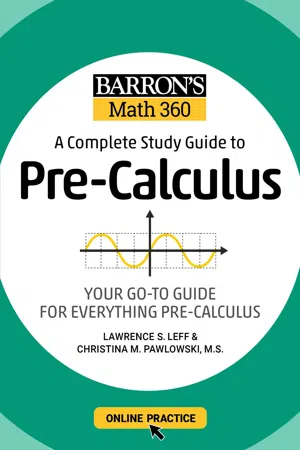Factoring Quadratic Equations
Factoring quadratic equations involves finding the two binomial factors of a quadratic expression. This process helps to solve quadratic equations and graph parabolas. By factoring, we can easily identify the roots or x-intercepts of the quadratic equation, which are the points where the parabola intersects the x-axis. This method is a fundamental skill in algebra and calculus.
4 Key excerpts on "Factoring Quadratic Equations"
- Sandra Rush(Author)
- 2013(Publication Date)
- Research & Education Association(Publisher)
...For example, because –5 divides evenly into each term in the numerator. If the coefficient of the x 3 term had been a 7, then we wouldn’t have been able to do this division so smoothly. By the way, the reason we say most (and not all) bets are off is that it can be done, but we’ll leave that to the mathematicians. Just as factoring was important when dividing any two quantities, whether they are numbers, fractions, or anything else, factoring is an important part of dividing two polynomials. For example, by recognizing that there is a common factor (x) in the numerator and denominator of we get In fact, in this example, the numerator can be factored further, and the whole expression equals (x + 5). But we are getting ahead of ourselves a little here. First we must talk about quadratic equations and how to factor them, the topic of the next section. Quadratic Equations A quadratic equation is an equation in which the unknown is squared and there is no higher power of the unknown. It is okay if there are no lower powers of the unknown (in other words, no “x” term or no “pure number” term). An example of a quadratic equation is x 2 + x –6 =0, and so are x 2 – 9 = 0 and x 2 +3 x = 0. Quadratic equations always have two answers for the value of the unknown (even though at times they are the same number twice). The general form of a quadratic equation is ax 2 + bx + c = 0, where b and c can be any numbers, even 0, as we saw with the examples of x 2 –9 = 0 and x 2 +3 x = 0. If a = 0, though, we no longer have a quadratic–according to the definition, there has to be a squared term. Solving a Quadratic Equation The solutions to a quadratic equation are based on a simple fact: if two factors are multiplied together and the product is 0, then either one or both of the factors must equal 0. There just are no two nonzero numbers whose product is 0. Period...
- Lawrence S. Leff, Christina Pawlowski-Polanish(Authors)
- 2021(Publication Date)
- Barrons Educational Services(Publisher)
...distribution. FACTORING x 2 + bx + c Since (x + 2)(x + 5) = x 2 + 7 x + 10, you know that x 2 + 7 x + 10 = (x + 2)(x + 5). Notice that the binomial factors contain 2 and 5 since these are the only two integers that, when multiplied together, give 10, the last term in x 2 + 7 x + 10, and, when added together, equal 7, the coefficient of the x- term in x 2 + 7 x + 10. If you start with x 2 + 7 x + 10 and want to know its factors, work in reverse: 1. Write the general form of the binomial factors: 2. Fill in the missing terms in the binomial factors with the two numbers whose product is the last number term of the quadratic trinomial and whose sum is the numerical coefficient of the middle x -term. Since 2 · 5 = 10 and 2 + 5 = 7: Always check your work by multiplying the two binomial factors together and then comparing the product to the original quadratic trinomial. EXERCISE 1 Factoring a Quadratic Trinomial Factor y 2 − 7 y + 12 as the product of two binomials. SOLUTION Find the two numbers whose product is +12 and whose sum is –7. Because the product of the two numbers you are seeking is positive (+12) and their sum is negative (−7), both numbers must be negative. Since (–3) · (–4) = +12 and (–3) + (–4) = –7 the correct factors of +12 are −3 and −4. Hence: y 2 – 7 y + 12 = (y – 3)(y – 4) EXERCISE 2 Factoring a Quadratic Trinomial Factor n 2 − 5 n − 14 as the product of two binomials. SOLUTION Find the two numbers whose product is −14 and whose sum is −5. The two factors of −14 must have opposite signs. Since (+2) · (–7) = –14 and (+2) + (–7) = –5, the correct factors of −14 are +2 and −7. Hence: n 2 – 5 n – 14 = (n + 2)(n – 7) FACTORING ax 2 + bx + c (a > 1) As you can imagine, factoring a quadratic trinomial becomes more difficult when the numerical coefficient of the x 2 -term is different from 1 since there are more possibilities to consider...
- eBook - ePub
Differentiating Instruction in Algebra 1
Ready-to-Use Activities for All Students (Grades 7-10)
- Kelli Jurek(Author)
- 2021(Publication Date)
- Routledge(Publisher)
...You must answer all of the questions. Name:────────── Hour/Block:───── Date:───── Lesson 3: Solving Using the Quadratic Formula Think Dots Directions : In your groups, each student will take turns rolling the die. Answer the corresponding question on the record sheet. You may discuss your answers with your group members before recording your answer. You must answer all of the questions. Name:────────── Hour/Block:───── Date:───── Lesson 3: Solving Using the Quadratic Formula Think Dots Record Sheet Circle worksheet chosen: Name:────────── Hour/Block:───── Date:───── Lesson 3: Solving Using the Quadratic Formula Exit Slip Write the quadratic formula. Explain why the quadratic formula can be used to solve any quadratic function. Explain why there may be two solutions to a real-life quadratic function application, but one answer can sometimes be eliminated. Lesson 4: Solving by Factoring Checkerboard Small-Group Activity Lesson Plan Purpose : Students will work in small groups (in pairs or groups of three) to put together the checkerboard puzzle that reviews identifying solutions to linear equations and identifying the slope and y -intercept from an equation. Prerequisite Knowledge Materials Needed Students should know: • how to find factors of numbers, • how to use FOIL to multiply binomials, • the exponent rules for multiplication, • how to combine like terms, and • the integer multiplication rules. • One copy of the checkerboard for each small group of students, cut into the squares • Scrap paper for solving equations Lesson ➤ Teachers may want to use random grouping. Each group should receive a packet of the puzzle pieces that are in no particular order. ➤ Students are asked to put together the checkerboard by matching pieces that have questions and answers that go together. There is no particular message revealed when the puzzle is completed. ➤ Students may notice that there are puzzle pieces that are blank on one side of the piece...
- eBook - ePub
GMAT Advanced Quant
250+ Practice Problems & Online Resources
- (Author)
- 2020(Publication Date)
- Manhattan Prep(Publisher)
...Quadratic Templates On the GMAT, quadratic expressions take three common forms called the Quadratic Templates. Memorize these templates, and get comfortable transforming back and forth between factored and distributed form: Factored Distributed Square of a Sum (a + b) 2 = a 2 + 2 ab + b 2 Square of a Difference (a − b) 2 = a 2 − 2 ab + b 2 Difference of Two Squares (a + b) (a − b) = a 2 − b 2 Quick Manipulation Expressions with both squared and non-squared common terms should make you suspect that you are looking at a Quadratic Template. Try-It #6-4 Factor. This problem requires you to manipulate a rather complicated expression. However, by using the common terms, you can put the problem in the more basic template form to solve: Once you are comfortable with Quadratic Templates, you can manipulate even complicated expressions quickly, as in the middle box above. Until then, write down the templates and the substitution of the common terms, as in the box on the right. The very same problem could have been presented in disguise: Factor. The common terms are slightly harder to spot in this form. In such a case, start with the squared terms, and 25 y 2. Then, try to untangle their square roots, and 5 y, from the remaining term. The factored form is: Consider all three of the common Quadratic Templates before deciding which one or ones are most convenient to use. The Middle Term: 2 ab The square of a sum and s quare of a difference templates have something in common: the middle term is ±2 ab. The only difference is the sign of that middle term. When you add these two templates, the middle terms cancel, leaving the end terms: Factored Distributed Square of a Sum (a + b) 2 = a 2 + 2 ab + b 2 + Square of a Difference (a − b) 2 = a 2 − 2 ab + b 2 Addition: (a + b) 2 + (a − b) 2 = 2 a 2 + 0 + 2 b 2 2(a 2 + b 2) In contrast, when you subtract these two templates, the end terms cancel, leaving...



